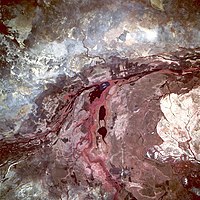
Photo from wikipedia
Floating-vegetation island (FVI) is widely used in river restoration projects for it can help decontaminate the pollutants. A physical experiment is conducted to explore the flow regime near FVI aiming… Click to show full abstract
Floating-vegetation island (FVI) is widely used in river restoration projects for it can help decontaminate the pollutants. A physical experiment is conducted to explore the flow regime near FVI aiming to better understand the role FVI serve in river systems. According to the observed data reflecting the mean and turbulent flow characteristics, the flow field has been subdivided into four regions: the incoming flow adjustment region, initial adjustment region, shear layer developing region and fully developed region. The changing process of the velocity profile is discussed that a “J” shape in the incoming flow adjustment region evolves to a “S” similar shape in the shear layer developing and fully developed region. The velocity in the interface between the canopy and the flow in the fully developed region obeys the rule of a mixing layer theory. Based on the experiment data, a three-layer model in estimating the vertical velocity distribution in the fully developed region is deduced and performs well with laboratory findings in current work and historical research
Journal Title: Journal of Hydrodynamics
Year Published: 2018
Link to full text (if available)
Share on Social Media: Sign Up to like & get
recommendations!